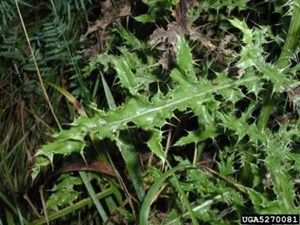
NPS Photo/ Mel Harte Plant Description
Canada thistle (Cirsium arvense) is an erect, perennial, herbaceous plant that grows to 4 ft (1.2 m) tall. It is the only thistle occurring in Lassen Volcanic NP that has an extensive creeping rootstock. The leaves are smooth, irregularly lobed, and 2-6 in (5-15 cm) long with prickly margins. The stems are relatively slender, sparingly branched, ridged and hairy. The flowers are purple to white and up to 0.5 in (1.8 cm) in diameter. Flowering occurs in late June through August. Canada thistle is native to Europe and Asia and was accidentally introduced to North America in the 1600s.

Habitat and Park Distribution
Canada thistle has been reported five times in Lassen Volcanic NP and had not been found in the park between 2006-2012. However, targeted surveys in the Reading Fire burned area recorded two new populations along Hat Creek. Historic sites along the west shore of Snag Lake were also rediscovered in 2013. Canada thistle occurs primarily in areas where soil moisture remains high throughout the growing season and where there is more sun than shade. It prefers wetter sites than bull thistle (Cirsium vulgare). Within the park, it is known from lake shores, riparian zones and perennial seeps on the margins of wet meadows. 
USDA-ARS/ Peggy Greb Ecology and Reasons for Concern
Canada thistle is a highly aggressive invasive species. Once established, it can spread rapidly into undisturbed wetlands, shorelines, and riparian areas. It forms dense stands that tend to shade out and displace native vegetation. The end result is a monoculture of thistle of use to few wildlife species other than a few nectar-feeding insects and birds. Once established, Canada thistle is extremely difficult to eradicate. Pulling or digging only fragments the root stocks and encourages spread, and the most effective herbicides cannot be used in or near water. The seeds have a feathery pappus which allows them to be dispersed long distances by wind. Wetlands far downwind from established thistle populations are therefore at risk. Read about the presence and treatment of Canada Thistle after the 2012 Reading Fire.
|
Last updated: February 28, 2015
